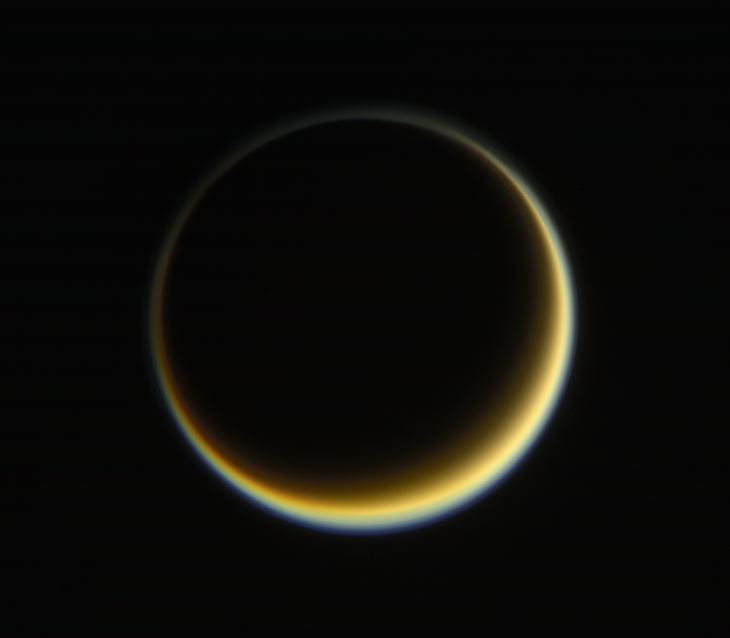Have you ever wondered if any moons in our solar system have a dense atmosphere like Earth’s? As far as scientists know, Saturn’s moon Titan is the only one. Earth is 2.5 times bigger than Titan, but the atmospheric pressure on Titan’s surface is 1.5 times stronger than that on Earth. Researchers studying Titan’s atmosphere from the Huygens mission data found that it’s made up of about 94% nitrogen, 6% methane, 0.1% hydrogen, and smaller amounts of complex organic molecules forming an organic haze.
Scientists in the past hypothesized that Titan’s haze formed from nitrogen and methane breaking apart when they’re hit by sunlight, then recombining to make new organic molecules. However, this hypothesis doesn’t explain the presence of some complex organic molecules that need extremely hot temperatures to form.
Other researchers recently suggested that these complex organic molecules formed during meteoroid shock events in the atmosphere of Titan. They point out that Titan orbits close to Saturn’s E-ring, a diffuse area of organic dust and meteoroids coming from Saturn’s other moon, Enceladus. The researchers proposed that once this material hits Titan’s atmosphere, it could collide with the surrounding particles and generate enough heat to trigger chemical reactions that form organic haze.
To test this new hypothesis, researchers from Princeton built a model to predict what molecules would form when meteoroid shocks occurred in Titan’s atmosphere. They took advantage of recent observations of Saturn’s rings from the Cassini mission to estimate the abundance of meteoroids at Saturn and the frequency at which they collide with one another and with other nearby moons like Titan. They combined these new observations with data on Titan’s atmospheric chemistry and temperature from the Huygens probe to estimate the variety of organic molecules that could form under shock conditions in the atmosphere.
Using their model, the researchers estimated that only meteoroids heavier than about 0.02 grams or 1/1000 of an ounce, about the weight of a rice grain, caused shock events in Titan’s atmosphere. Researchers in the past showed that most of the material falling into Titan’s atmosphere comes from a big meteoroid-rich shell surrounding our Solar System, called the Oort Cloud. However, this team found that particles from the Oort Cloud are on average too small to trigger atmospheric shock events in Titan’s atmosphere. On the other hand, the organic-rich material coming from Enceladus has a bigger size range that makes shock events more likely.
The researchers also predicted that a high-temperature zone forms around each meteoroid as it falls through the atmosphere, which they called the cylindrical shock wave. They calculated that this wave reaches temperatures as high as 10,000 K (or 17,540 °F). They also calculated that reactive nitrogen-containing species form at ~ 2,500 K (or 4,040 °F) and other complex organic molecules at even lower temperatures. They suggested these results meant complex organics could be synthesized in the areas directly in front of and behind the meteoroid during its fall. They explained that in these locations the gasses heat up enough to split into smaller molecules and then recombine into more complex ones as they cool down.
The team also calculated how many gas molecules can smash into each other based on their density and temperature at different heights in Titan’s atmosphere. They found that at 400 km (or 250 miles) of altitude, the meteoroids can synthesize organic molecules by shock events most efficiently. They highlighted that this altitude coincides with the haze layer in Titan’s atmosphere, such that meteors coming from Enceladus could be contributing to this organic-rich region as they degrade during their fall.
The researchers concluded that meteoroids from Enceladus falling into Titan’s atmosphere could form Titan’s iconic haze layer. But the team cautioned that they had to assume the frequency at which middle-sized meteoroids fall on Titan in their models, as those are too small to see with telescopes but too big to measure with mission instruments. They suggested researchers use observations of Titan’s atmosphere from future missions like Dragonfly to test these assumptions and further validate their model.


